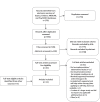Beyond the Trial: Systematic Review of Real-World Uptake and Engagement With Digital Self-Help Interventions for Depression, Low Mood, or Anxiety
- PMID: 29875089
- PMCID: PMC6010835
- DOI: 10.2196/jmir.9275
Beyond the Trial: Systematic Review of Real-World Uptake and Engagement With Digital Self-Help Interventions for Depression, Low Mood, or Anxiety
Abstract
Background: Digital self-help interventions (including online or computerized programs and apps) for common mental health issues have been shown to be appealing, engaging, and efficacious in randomized controlled trials. They show potential for improving access to therapy and improving population mental health. However, their use in the real world, ie, as implemented (disseminated) outside of research settings, may differ from that reported in trials, and implementation data are seldom reported.
Objective: This study aimed to review peer-reviewed articles reporting user uptake and/or ongoing use, retention, or completion data (hereafter usage data or, for brevity, engagement) from implemented pure self-help (unguided) digital interventions for depression, anxiety, or the enhancement of mood.
Methods: We conducted a systematic search of the Scopus, Embase, MEDLINE, and PsychINFO databases for studies reporting user uptake and/or usage data from implemented digital self-help interventions for the treatment or prevention of depression or anxiety, or the enhancement of mood, from 2002 to 2017. Additionally, we screened the reference lists of included articles, citations of these articles, and the titles of articles published in Internet Interventions, Journal of Medical Internet Research (JMIR), and JMIR Mental Health since their inception. We extracted data indicating the number of registrations or downloads and usage of interventions.
Results: After the removal of duplicates, 970 papers were identified, of which 10 met the inclusion criteria. Hand searching identified 1 additional article. The included articles reported on 7 publicly available interventions. There was little consistency in the measures reported. The number of registrants or downloads ranged widely, from 8 to over 40,000 per month. From 21% to 88% of users engaged in at least minimal use (eg, used the intervention at least once or completed one module or assessment), whereas 7-42% engaged in moderate use (completing between 40% and 60% of modular fixed-length programs or continuing to use apps after 4 weeks). Indications of completion or sustained use (completion of all modules or the last assessment or continuing to use apps after six weeks or more) varied from 0.5% to 28.6%.
Conclusions: Available data suggest that uptake and engagement vary widely among the handful of implemented digital self-help apps and programs that have reported this, and that usage may vary from that reported in trials. Implementation data should be routinely gathered and reported to facilitate improved uptake and engagement, arguably among the major challenges in digital health.
Keywords: anxiety; depression; e-therapy; eHealth; mobile applications.
©Theresa Fleming, Lynda Bavin, Mathijs Lucassen, Karolina Stasiak, Sarah Hopkins, Sally Merry. Originally published in the Journal of Medical Internet Research (http://www.jmir.org), 06.06.2018.
Conflict of interest statement
Conflicts of Interest: TF, KS, ML, and SM are codevelopers of SPARX (a form of computerized therapy for depression cited in this paper). The intellectual property for SPARX is owned by Uniservices at the University of Auckland. The codevelopers can benefit financially from its commercialization outside New Zealand. The remaining authors have no conflicts of interest to declare.
References
-
- Andrews G, Cuijpers P, Craske MG, McEvoy P, Titov N. Computer therapy for the anxiety and depressive disorders is effective, acceptable and practical health care: a meta-analysis. PLoS One. 2010;5(10):e13196. doi: 10.1371/journal.pone.0013196. http://dx.plos.org/10.1371/journal.pone.0013196 - DOI - DOI - PMC - PubMed
-
- Ebert DD, Zarski A, Christensen H, Stikkelbroek Y, Cuijpers P, Berking M, Riper H. Internet and computer-based cognitive behavioral therapy for anxiety and depression in youth: a meta-analysis of randomized controlled outcome trials. PLoS One. 2015;10(3):e0119895. doi: 10.1371/journal.pone.0119895. http://dx.plos.org/10.1371/journal.pone.0119895 - DOI - DOI - PMC - PubMed
-
- Rogers MA, Lemmen K, Kramer R, Mann J, Chopra V. Internet-delivered health interventions that work: systematic review of meta-analyses and evaluation of website availability. J Med Internet Res. 2017 Mar 24;19(3):e90. doi: 10.2196/jmir.7111. http://www.jmir.org/2017/3/e90/ - DOI - PMC - PubMed
-
- Fleming TM, de Beurs D, Khazaal Y, Gaggioli A, Riva G, Botella C, Baños RM, Aschieri F, Bavin LM, Kleiboer A, Merry S, Lau HM, Riper H. Maximizing the impact of e-therapy and serious gaming: time for a paradigm shift. Front Psychiatry. 2016;7:65. http://europepmc.org/abstract/MED/27148094 - PMC - PubMed
Publication types
MeSH terms
LinkOut - more resources
Full Text Sources
Other Literature Sources
Medical
Miscellaneous


